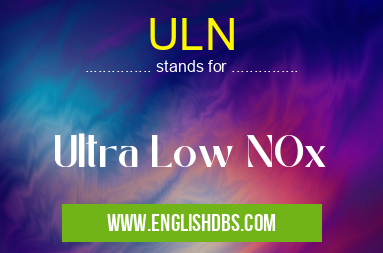What does ULN mean in UNIT MEASURES
ULN (Ultra Low NOx) is an acronym used in various industries, particularly in the context of emissions control. It refers to technologies and measures aimed at minimizing the release of nitrogen oxides (NOx) into the atmosphere. NOx emissions are a significant contributor to air pollution and can have adverse effects on human health and the environment.

ULN meaning in Unit Measures in Miscellaneous
ULN mostly used in an acronym Unit Measures in Category Miscellaneous that means Ultra Low NOx
Shorthand: ULN,
Full Form: Ultra Low NOx
For more information of "Ultra Low NOx", see the section below.
Understanding ULN
ULN technologies involve combustion optimization techniques, exhaust gas treatment systems, and fuel modifications that reduce the formation and emission of NOx. By employing ULN systems, industries can meet stringent environmental regulations and minimize their environmental footprint.
Key Features of ULN
- Low NOx Emissions: ULN technologies aim to reduce NOx emissions to extremely low levels, typically below 10 parts per million (ppm) or even lower.
- Combustion Optimization: ULN involves optimizing combustion processes to minimize NOx formation during the burning of fuels. This can be achieved through techniques such as staged combustion, low-temperature combustion, and exhaust gas recirculation.
- Exhaust Gas Treatment: ULN systems often utilize exhaust gas treatment devices, such as selective catalytic reduction (SCR) and selective non-catalytic reduction (SNCR). These systems inject reducing agents (e.g., urea, ammonia) into the exhaust stream to convert NOx into harmless compounds like nitrogen and water.
- Fuel Modifications: In some cases, ULN may involve modifications to the fuel itself. For example, using low-sulfur fuels or blending fuels with emissions-reducing additives can contribute to lower NOx emissions.
Benefits of ULN
- Improved Air Quality: ULN technologies significantly reduce air pollution by minimizing NOx emissions, which contribute to the formation of smog and acid rain.
- Health Benefits: Reducing NOx emissions improves air quality, leading to positive health outcomes for humans, including reduced respiratory ailments and cardiovascular diseases.
- Environmental Protection: ULN helps preserve ecosystems by mitigating the environmental impacts of NOx emissions, which can damage vegetation and contribute to biodiversity loss.
- Regulatory Compliance: ULN technologies enable industries to comply with increasingly stringent environmental regulations governing NOx emissions.
Essential Questions and Answers on Ultra Low NOx in "MISCELLANEOUS»UNITMEASURES"
What is Ultra Low NOx?
Ultra Low NOx (ULN) refers to combustion technologies designed to minimize the emission of nitrogen oxides (NOx) from combustion sources. NOx pollutants, primarily nitrogen monoxide (NO) and nitrogen dioxide (NO2), contribute to air pollution and environmental issues such as smog and acid rain.
How does ULN technology operate?
ULN technologies employ various techniques to reduce NOx formation during combustion. These include:
- Lean combustion: Operating combustion systems with less fuel than the stoichiometric air-fuel ratio, resulting in lower flame temperatures and reduced NOx production.
- Staged combustion: Dividing the combustion process into multiple stages, allowing for precise control of temperature and air-fuel mixing to minimize NOx formation.
- Selective Catalytic Reduction (SCR): Using a catalyst to convert NOx emissions into harmless nitrogen and water in the presence of a reducing agent like ammonia or urea.
What industries use ULN technology?
ULN technologies are primarily employed in industries where combustion processes are prevalent, such as:
- Power generation (fossil fuel and gas turbine power plants)
- Industrial boilers and furnaces
- Transportation (diesel engines, marine vessels)
- Manufacturing processes involving combustion
What are the benefits of ULN technology?
ULN technologies offer significant environmental and economic benefits:
- Reduced air pollution and improved air quality
- Compliance with increasingly stringent environmental regulations
- Improved fuel efficiency and cost savings by optimizing combustion processes
- Enhanced combustion stability and reduced maintenance costs
Are there any challenges associated with ULN technology?
While ULN technologies provide numerous advantages, they also present some challenges:
- Higher capital investment and operating costs compared to conventional combustion systems
- Potential for ammonia slip (release of ammonia) when using SCR systems
- Technical complexity and the need for specialized expertise for design and operation
Final Words: ULN (Ultra Low NOx) plays a crucial role in minimizing NOx emissions and protecting the environment. Through combustion optimization, exhaust gas treatment, and fuel modifications, ULN technologies enable industries to reduce their environmental impact and contribute to a cleaner and healthier planet. As environmental regulations continue to evolve, ULN will remain an indispensable tool for achieving sustainable emissions control.
ULN also stands for: |
|
| All stands for ULN |
